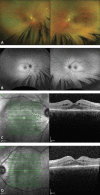UVEITIS CAUSED BY TREATMENT FOR MALIGNANT MELANOMA: A CASE SERIES
- PMID: 31274846
- PMCID: PMC8542090
- DOI: 10.1097/ICB.0000000000000876
UVEITIS CAUSED BY TREATMENT FOR MALIGNANT MELANOMA: A CASE SERIES
Abstract
Background/purpose: To report the largest case series to date of uveitis occurring in association with immunomodulatory therapy for malignant melanoma.
Methods: A retrospective multicenter case review. Twenty-two patients with uveitis occurring in association with either immunotherapy or targeted immune therapy for malignant melanoma were identified.
Results: Of 22 patients, 11 had anterior uveitis in isolation. The remainder showed a variety of clinical features including panuveitis, ocular hypotony, papillitis, cystoid macular edema, and melanoma-associated retinopathy. Most patients responded well to treatment.
Conclusion: We report the largest case series to date of patients with uveitis secondary to drug treatment for malignant melanoma. These cases are likely to increase in number in the future as newer immunomodulatory therapies for cancers are developed and the indications for these drugs increase. A dilemma arises when patients respond well to these drugs but develop vision-threatening side effects.
Copyright © 2019 The Author(s). Published by Wolters Kluwer Health, Inc. on behalf of the Opthalmic Communications Society, Inc.
Conflict of interest statement
None of the authors has any financial/conflicting interests to disclose.
Figures


References
-
- Choe CH, McArthur GA, Caro I, et al. . Ocular toxicity in BRAF mutant cutaneous melanoma patients treated with vemurafenib. Am J Ophthalmol 2014;158:831–837. - PubMed
Publication types
MeSH terms
LinkOut - more resources
Full Text Sources
Medical

